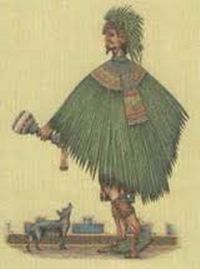Travel to Vienna
After Moctezuma assassination in June 1520, the crown of feathers was sent to Spain and King Charles V along with other treasures in 1521.
Charles V (born February 24, 1500 in Ghent - Belgium, † September 21, 1558, in Extremadura Spain) was a relative of the Habsburg dynasty, King of Spain and as Charles I, Emperor of the Holy Roman Empire, also Emperor of Belgium, Hungary, Germany and Austria.
In 1575 the feather crown is in the inventory of the art chamber of Count Ulrich von Montfort in Tettnang, Upper Swabian administrations (after death).
The Counts of Montfort were a noble family that belonged to the ruling high nobility of the Holy Roman Empire. The family died out in 1787.
Count Ulrich von Montfort and Rothenfels, last count of the Montfort-Tettnang line, ruled from 1564 to March 16, 1574 (death). He was an art collector from 1567.
From 1590 the crown is said to have passed into the possession of Archduke Ferdinand II of Tyrol, a nephew of King Charles V. He set up an arms collection and art chamber at Ambras Castle, which at that time was one of the most important collections of its kind north of the Alps.
An inventory list was also made after his death, namely in 1596. The crown of feathers, which is said to have been in the 9th box, is also mentioned here: "Mer ain Mörischer Huet of long beautiful glistening, Greek-white and gold feathers, with white, red and blue-colored feathers at the top Feathers, with gulden Roslen, and geflunder exposed, has on the front of the forehead, ain whole gulden Schnabl."
Ambras Castle, Innsbruck, Austria
Also, in the collection: an Aztec feather shield, a feather fan, Taraskan featherwork, a "Mörischer roeckh", lost since the 18th century, as well as a "Mörischer plume, so a horse belongs on the forehead". Other pieces are present but not mentioned in the list. Two feather shields were burned in a court garden in Innsbruck in 1629.
The collection passed from the private property of the heirs to the property of the House of Habsburg. The collection was relocated several times and exhibited in the Lower Belvedere after 1814.
From 1621 the "Mörische huet" is described as Indian and in 1788 as an apron, probably because after 1730 the golden helmet "disappeared". The "mörische roeckh" has been deleted from the inventory. After 1621, box 9 was moved to box 11, and in 1788 to box 4 of the third part of the exhibition.
In the spring of 1878, the feather crown was found "folded up in the corner of wall box XVI in room 5", ignored and hardly noticeable in the overcrowded box. In 1880 it was transferred to state ownership and inventoried under number 3366 of the ethnographic collection as the "Old Mexican splendor standard". In 1878 an amateur restoration took place because it was eaten by moths. Afterwards it was estimated at a value of 3000 guilders behind mirror glass on a black velvet background.
Approx. In 1884 it was transferred to the Natural History Museum and renumbered to the number 10402, which is still valid today, from August 10th, 1889, the crown was made accessible to the public hanging on the wall with the following description: "The famous splendid feather headdress, that of Emperor Moctezuma through mediation was sent to Europe by Ferd Cortez and came into the collection of Archduke Ferdinand of Tyrol at Ambras Castle ".
After investigations (including the back of the crown) in 1908, it is now officially referred to as "headdress".

